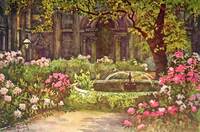Few people who have not entered the Bank of England would suspect it of enclosing an extremely pretty garden. There the inner courtyard possesses tall lime trees, gay rhododendrons, and a cool splashing fountain, with ferns and iris glistening in the spray. It is quite one of the most delightfully fresh and peaceful corners on a hot summer's day, and carries one in imagination to Italy. Yet this is but another of the many old City churchyards. The parish of St. Christopher-le-Stocks was absorbed, with five other parishes, into St. Margaret's, Lothbury, in 1781. Some of the tombs, and pictures of Moses and Aaron, were removed from it, and are still to be seen in St. Margaret's, which is crowded with monuments from all six churches. The Bank was already in possession of most of the land within the parish, and by the Act of Parliament of 1781, the church and churchyard became part of the Bank premises, which cover nearly three acres. The church site was built over, but the graveyard became the garden. This enclosure at first was a simple grass plot, as shown in an engraving dated 1790. The lime trees may have been planted soon after, as they appear as large trees sixty years later, and are spoken of in 1855 as two of the finest lime trees in London. The fountain was put up in 1852 by Mr. Thomas Hankey, then the governor. The water for it came from the tanks belonging to the Bank, supplied by an artesian well 330 feet deep, said to be very pure, and free from lime. Perhaps that is why the rhododendrons look so flourishing. Most of the Bank, as is well known, was the work of the architect Sir John Soane, but some of the portions built by Sir Robert Taylor, before his death in 1788, when Soane was appointed to succeed him, are to be seen in the garden court. It is said that the last person buried there was a Bank clerk named Jenkins, who was 7.5 feet in height. He was allowed to rest there, as he feared he might be disinterred on account of his gigantic proportions.

